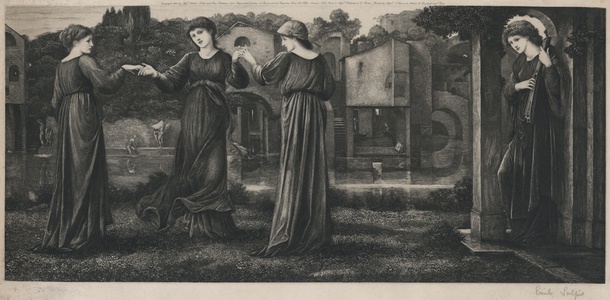| Method | Etching |
| Artist | Émile-Jean Sulpis after Sir Edward Coley Burne-Jones |
| Published | Copyright 1899 by Messrs. Arthur Tooth and Sons Publishers, 5 & 6 Haymarket, London, 41, Boulevard des Capucines, Paris 299, Fifth Avenue New York & Messrs. Stiefbold & Co. Berlin. Printed by Messrs. A. Salmon & Ardail, A. Porcabeuf succr. Paris |
| Dimensions | Image 240 x 527 mm, Sheet 324 x 632 mm |
| Notes |
Signed in pencil by the engraver. One of 25 Presentation Proofs not on vellum. An etching of Burne-Jones' Renaissance inspired 'The Mill'. The scene shows three female figures dancing hand in hand on a river bank. A fourth, more androgynous figure, standing beneath a loggia, plays a lute. In the distance, nude figures can be seen bathing by the stream. Speaking of 'The Mill', Burne-Jones admitted that he made deliberate reference to Botticelli's 'Primavera' with his dancing figures, and Piero's 'Baptism of Christ' with the male bathers. A town is seen in the background consisting of architecture that appears to combine features of the Renaissance and Middle Ages with those of a more contemporary nature. Housed within the buildings are three mills. 'The Mill' was inspired by 'The Allegory of Good and Bad Government', a mural painted by Italian Renaissance artist Ambrogio Lorenzetti between 1338 and 1340 but as with many works produced by Burne-Jones, and more broadly speaking, those produced by artists associated with the Aesthetic Movement, 'The Mill' lacks any distinct narrative. Instead, an overt emphasis is placed on beauty, and engaging with the senses. Burne-Jones was commissioned to produce this painting by Constantine Alexander Ionides, a patron and collector. Burne-Jones modelled the three dancing figures on Maria Zambaco, his mistress, Marie Spartali Stillman, a prominent Pre-Raphaelite artist, and Aglaia Coronio. The three women were cousins and relatives of Ionides, and were known among friends as the 'Three Graces'. The painting from which this etching was taken is now in the collection of the Victoria and Albert Museum. Émile-Jean Sulpis (1856 - 1942) was a French artist, engraver and designer. Born in Paris, Sulpis' father was the architectural engraver, Jean-Joseph Sulpis. Sulpis taught at the École Estienne and he first exhibited at the salon in 1880. Sulpis is most known for his interpretations and engravings after works by Renaissance artists including Michelangelo and Mantegna. Sir Edward Coley Burne-Jones, 1st Bt (1833-1898) was a painter and designer closely associated with the later phase of the Pre-Raphaelite movement. Burne-Jones met William Morris as an undergraduate of Exeter college, Oxford, whilst studying for a degree in theology. The pair went on to work very closely together on numerous decorative arts projects including stained glass windows, tapestries and illustrations. Originally intending to become a church minister, Burne-Jones never finished his degree, choosing instead to pursue an artistic career under the influence of Dante Gabriel Rossetti. Rossetti heavily inspired his early work, but by the 1860's his idiosyncratic style was beginning to develop. His mature work, however different in total effect, is rich in conscious echoes of Botticelli, Mantegna and other Italian masters of the Quattrocento. Thusly, Burne Jones' later paintings of classical and medieval subjects are some of the most iconic of the Pre-Raphaelite movement. He was at the height of his popularity during the 1880's, though his reputation began to decline with the onset of the Impressionists. He was created a baronet in 1894, when he formally hyphenated his name. Printsellers' Association (1912), Edition declared on October 30, 1899, 250 Artist's Proofs on vellum at 10 guineas and 25 Presentation Proofs, only state, and the plate was to be destroyed. Hartnoll 14. Condition: Good impression. Professionally laid to archival tissue. Some staining to margins. Framed in a decorative period style frame. |
| Framing | framed |
| Price | £3,000.00 |
| Stock ID | 51757 |

